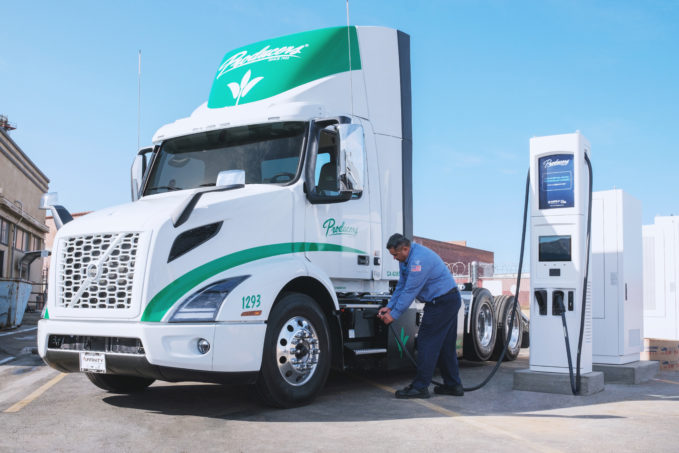
By Ed Pierce, Contributing Editor
May 8, 2022
“All vertical fleet markets want to become electric,” says Sean Larkin, Director of Sales and Business Development for Amply Power. “There is a demand in the marketplace. The vehicles themselves are the true drivers.”
This trend toward electrification is evident and growing every year. Companies are setting goals to limit their carbon footprint and making the transition towards all-electric fleets. EVs have been ready, available, and deployed for quite some time now, and an upcoming surge in light- and medium-duty vehicles is all but certain.
In order to effectively make that transition, however, fleet operators have to do a lot more than just onboard a few electric vehicles. They need a solution that can handle the infrastructure and charging aspects of electrification while guiding them through the design, deployment, operation, and maintenance of their new EV charging infrastructure.
 Says Sean, “This is where Amply Power comes in. Developed in 2018, Amply consists of a leadership team experienced in the field of distributed energy and storage. The goal as a company is to help fleet managers address the challenges of electrification, in particular the difficulties presented by EV charge management.”
Says Sean, “This is where Amply Power comes in. Developed in 2018, Amply consists of a leadership team experienced in the field of distributed energy and storage. The goal as a company is to help fleet managers address the challenges of electrification, in particular the difficulties presented by EV charge management.”
The Challenges of Electrification
Making the transition from internal combustion engine (ICE) vehicles to electric vehicles (EVs) is a complex process for any fleet manager. Unlike ICE vehicles, which are able to fuel anywhere and are well-known by fleet operators and drivers alike, EVs are a whole new playing ground. Electrification presents several challenges, although most are becoming less and less difficult to overcome as acceptance and awareness of electric vehicles grows.
The first obstacle facing fleet managers looking to electrify their fleet is the lack of widespread charging infrastructure. An EV is useless without the ability to charge it, which is why it’s important to consider infrastructure early on in the adoption process. The fleets that have had the most success electrifying are those which formed a strong stakeholder group early in the process to help them detect traps and grasp the road maps ahead of them.
In addition to charging infrastructure, electrification is also hindered by fluctuating electricity costs. Unlike traditional fuels that could increase by 20-30% in a year, electricity rates can increase by as much as 100-300% in a single day. Fleet managers can’t establish a consistent or accurate estimation of costs when dealing with such inconstant pricing. The increased fluctuation requires a highly rigorous strategy to ensure that the expenses of fueling new electric vehicles are maintained to a minimum.
The last obstacle to electrification is the issue of charging time. Fleet managers need to know that their vehicles will have sufficient time to charge and complete their duty cycle out in the field. One of the biggest advantages of EVs is their interoperability, as there is quite a bit of data sharing between vehicles, chargers, utilities, and more. But in order to actually make use of this information and ensure that EV charging and deployment runs smoothly, you need a solution that can track and monitor EV charging data and performance.
Amply Power to the Rescue
Most vehicle and charger OEMs seek to solve one or two of these issues, which means that fleet managers are often forced to work with multiple companies in order to manage their transition toward electric vehicles. While they have myriad choices for pieces of the solution, Amply Power brings together the pieces for a complete solution.
Amply Power is an infrastructure and energy management supplier for fleets that drive heavy, medium, and light duty vehicles, explains Sean. “We work with fleet managers throughout the country and around the world, providing them with a unified solution and a user-friendly dashboard that provides real-time visibility for all the factors needed to manage an electric fleet.”
In order to combat the lack of charging infrastructure, Amply offers charging as a service, including the installation, design, deployment, and operation of charging depots. “We also offer a single operating cost to fleet managers, negating the fluctuating prices of electricity and maximizing efficiency,” adds Sean.
One of the biggest assets of Amply is its charge management platform, called OMEGA. Sean notes that this platform functions as a 24/7 network operations center, providing real-time visibility to your EVs, chargers, and power usage, as well as automated, hands-free control of the chargers.
“Fleet managers can access OMEGA on any web browser or mobile device, overseeing their EV charging stations and vehicles in real-time,” notes Sean. “OMEGA allows users to track current and maximum electrical capacity at their fleet depot and follow each vehicle’s state-of-charge and time-to-completion charging estimates. It also automatically manages charging cycles to take advantage of low-cost electricity pricing, battery health, carbon impact, and more, as well as sending instant fault notifications and critical alerts to warn of issues.”
The top priority for fleet managers is uptime. They need to know that all their vehicles are running day in and day out, and their greatest fear regarding EVs is that they won’t be charged and ready to go when they need them. “With OMEGA, we are able to guarantee uptime for its users. Our management team and network operating center monitors every vehicle and charger to ensure they’re operational at all times,” says Sean.
Starting the Transition
As fleet managers start the process of electrification, it’s important to involve all of the trusted stakeholders as early on in the process as possible, cautions Sean. “You need a robust energy management plan that ensures you’ll have the necessary infrastructure set up to charge your fleet once it arrives. We serve as a trusted advisor to manage fleet charging all in one place, assisting in the fleet electrification journey.”
A truly successful electrification depot or field deployment requires planning and forethought, just as it does for the rollover and turnover of automobiles. Concludes Sean, “Fleet managers have to look ahead and start integrating things into the existing infrastructure if they want a successful transition from pilot to production. This requires the introduction of energy and charge EV management solutions like Amply’s to ensure the transition from an all-ICE fleet to EV fleet is as seamless as possible.”



